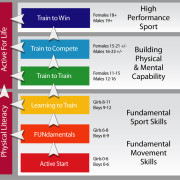LTAD PHASE 3 AND 4
Last week we looked at the Canadian Sport Centres Long Term Athlete Development (LTAD) program by explaining the FUNdamental stage. The LTAD focuses on the general framework of athlete development with special reference to growth, maturation and development, trainability, and sport system alignment and integration.
This week we will look at Phase three, four and five of the process.
Phase three, for our purposes, includes Training to Train and Training to Compete.
Train to Train – this stage is defined by the onset to the end of the growth spurt. We can now call them young athletes as they consolidate basic sport-specific skills and tactics. During this stage there is accelerated adaptation to aerobic, speed, and strength training. It is important to mark peak height velocity as this is the time when their bodies are fully prepared to develop the above training attributes. It is important to maintain flexibility and mobility during this rapid growth period. These young athletes may play to win and do their best, but they still need time for skill training and physical development. Skill training should make up 60% of the athletes time with 40% on competition. Competition focuses on the practice of technical/tactical skills as well as decision making. This is the stage where coaches and parents can start to identify talent and start the specialization process. The warning is that this is also the stage when many young athletes quit their sport due to burnout or excessive pressure from coaches and parents. Make sure your athlete is mature enough to handle specialization…their is still time.
It is stated in the Canadian Sport for Life Long Term Athlete Development Resource Paper – “the Learn to Train and Train to Train stages are the most important stages of athletic preparation. During these stages, we make or break an athlete!”
Train to Compete – is the stage where things get serious. The stage starts at age 15 for girls and 16 for boys and continues into the early 20’s. Sport, event, and position specific physical conditioning, technical, tactical and playing skills under competition like conditions are implemented. High volume and high intensity are introduced in year round programs. The athlete may be training specifically 9 – 12 times per week. The athlete needs the most skilled and qualified coaches to ensure physical, mental and emotional development.
Phase four is the Training to Win phase and for most sports starts at 18 for females and 19 for males. This is the stage where elite athletes are training at the most intense levels to compete at the international level. All training and preparation is world class and focused on the sport and athlete.
The last phase is Active for Life. This stage can be entered at any age if physical literacy was developed efficiently in the early years. The athlete moves from competitive sport to recreational and those who did not purpose sport as a child can still participate at a level that allows for health and wellness as a result of having the necessary motor skills and confidence. Success in the fundamental and learning to train stages should allow the participant to choose from a large number of recreational pursuits. Being Active for Life can set an example for our children and peers by modeling healthy lifestyles.
More information can be found at ltad.ca or ask me to see any of the Canadian Sport Centre’s resource material.




